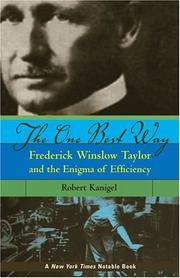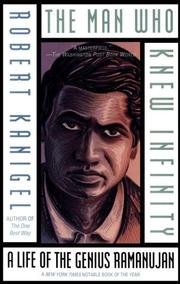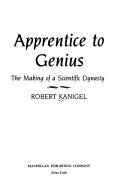| Listing 1 - 10 of 11 | << page >> |
Sort by
|

ISBN: 0262612062 9780262612067 Year: 2005 Publisher: Cambridge, Mass. MIT
Abstract | Keywords | Export | Availability | Bookmark
 Loading...
Loading...Choose an application
- Reference Manager
- EndNote
- RefWorks (Direct export to RefWorks)
Personnel management --- Taylor, Frederick Winslow --- Industrial engineering. --- Industrial management. --- Génie industriel --- Gestion d'entreprise --- Taylor, Frederick Winslow, --- Génie industriel
Book
ISBN: 9780345803337 0345803337 Year: 2017 Publisher: New York Vintage Books
Abstract | Keywords | Export | Availability | Bookmark
 Loading...
Loading...Choose an application
- Reference Manager
- EndNote
- RefWorks (Direct export to RefWorks)
"Chronicles the life of a noted activist who wrote seven groundbreaking books, including her most famous, The Death and Life of Great American Cities; saved neighborhoods; stopped expressways; was arrested twice; and engaged at home and on the streets in thousands of debates -- all of which she won, "--NoveList. The first full-scale biography of Jane Jacobs, the irrepressible woman who with her book The Death and Life of American Cities, and others that followed, so profoundly changed the way we think about and live in cities that, to this day, her influence can still be felt in any discussion of urban planning, or in any conversation about what cities mean to us. Jacobs is brought to life here by Robert Kanigel, the writer who introduced us to Indian mathematician Ramanujan and to industrialist Fredrick Winslow Taylor. Based on new sources and interviews, as well as on archival letters and other material, this is a revelation of the phenomenal woman, who, while raising three children, wrote seven groundbreaking books; saved neighborhoods; was arrested twice; and engaged--at home, on the podium, and on the streets--in thousands of impassioned debates, all of which, it could seem, she won. Here is the girl who challenged her third-grade teacher; the high school poet; the journalist who honed her writing and observational skills at Architectural Forum, Fortune, and other magazines, while amassing the knowledge and contacts she would draw upon to write her most famous book. We accompany her on New York's streets as she forms her opinions about what makes a city grow or fail, and meet the architects and planners and power brokers she battled with so vigorously. Each of her books and its reception are thoroughly discussed. Here, too, is the activist who helped lead ultimately successful protests against Robert Moses's proposed expressway that would have cut off her beloved Greenwich Village; and who, in order to keep her sons out of the Vietnam War, moved to Canada, where she applied her ideas about what made cities thrive to a new setting, becoming as well known and admired there as she was in the United States. Eyes on the Street--Jacobs's phrase for the vital human presence in a healthy neighborhood--is a penetrating, engaging portrait of a woman of fearless spirit and int ellect whose every action and thought was often unexpected, always original and, ultimately, of lasting importance.--Adapted from dust jacket.
City planners --- City planning --- History --- Jacobs, Jane, --- Urban renewal --- Sociology, Urban --- Town planners --- Urbanists --- Architects --- Planners --- Philosophy --- Butzner, Jane, --- Urban sociology --- Cities and towns --- Model cities --- Renewal, Urban --- Urban redevelopment --- Urban renewal projects --- Land use, Urban --- Urban policy --- Civic planning --- Redevelopment, Urban --- Slum clearance --- Town planning --- Urban design --- Urban development --- Urban planning --- Land use --- Planning --- Art, Municipal --- Civic improvement --- Regional planning --- Government policy --- Management --- 72 JACOBS --- 72.036 <4> --- 711.4-163 <73> --- 711.4-163 <73> Planologie: stadsvernieuwing; stadsreconstructie--Verenigde Staten van Amerika. VSA. USA --- Planologie: stadsvernieuwing; stadsreconstructie--Verenigde Staten van Amerika. VSA. USA --- 72.036 <4> Moderne bouwkunst. Architectuur van de 20e eeuw--Europa --- Moderne bouwkunst. Architectuur van de 20e eeuw--Europa
Book
ISBN: 0356203301 9780356203300 Year: 1991 Publisher: New York (N.Y.): Scribner,
Abstract | Keywords | Export | Availability | Bookmark
 Loading...
Loading...Choose an application
- Reference Manager
- EndNote
- RefWorks (Direct export to RefWorks)
Book
ISBN: 9780307961907 9780307961914 Year: 2016 Publisher: New York, N.Y. Alfred A. Knopf
Abstract | Keywords | Export | Availability | Bookmark
 Loading...
Loading...Choose an application
- Reference Manager
- EndNote
- RefWorks (Direct export to RefWorks)
Sociology of environment --- Environmental planning --- urban planning --- urban sociology --- urban renewal --- activists --- Jacobs, Jane
Book
ISBN: 9780812221329 Year: 2010 Publisher: Philadelphia, Pa. : University of Pennsylvania Press,
Abstract | Keywords | Export | Availability | Bookmark
 Loading...
Loading...Choose an application
- Reference Manager
- EndNote
- RefWorks (Direct export to RefWorks)

ISBN: 0671750615 Year: 1992 Publisher: New York : Washington Square Press,
Abstract | Keywords | Export | Availability | Bookmark
 Loading...
Loading...Choose an application
- Reference Manager
- EndNote
- RefWorks (Direct export to RefWorks)
Mathematicians --- Mathematicians --- Mathématiciens --- Biography --- Biography --- Biographie --- Hardy, G. H. --- Ramanujan Aiyangar, Srinivasa,

ISBN: 0025606506 Year: 1986 Publisher: Macmillan
Abstract | Keywords | Export | Availability | Bookmark
 Loading...
Loading...Choose an application
- Reference Manager
- EndNote
- RefWorks (Direct export to RefWorks)
Drugs --- Mentoring in science --- Research --- History --- Brodie, Bernard B. --- Friends and associates.
Book
ISBN: 9780525520948 9780525520955 Year: 2021 Publisher: New York Knopf
Abstract | Keywords | Export | Availability | Bookmark
 Loading...
Loading...Choose an application
- Reference Manager
- EndNote
- RefWorks (Direct export to RefWorks)
From the acclaimed biographer of Jane Jacobs and Srinivasa Ramanujan comes the first full life and work of arguably the most influential classical scholar of the twentieth century, who overturned long-entrenched notions of ancient epic poetry and enlarged the very idea of literature. In this literary detective story, Robert Kanigel gives us a long overdue portrait of an Oakland druggist's son who became known as the "Darwin of Homeric studies." So thoroughly did Milman Parry change our thinking about the origins of Homer's Iliad and Odyssey that scholars today refer to a "before" Parry and an "after." Kanigel describes the "before," when centuries of readers, all the way up until Parry's trailblazing work in the 1930's, assumed that the Homeric epics were "written" texts, the way we think of most literature; and the "after" that we now live in, where we take it for granted that they are the result of a long and winding oral tradition. Parry made it his life's work to develop and prove this revolutionary theory, and Kanigel brilliantly tells his remarkable story--cut short by Parry's mysterious death by gunshot wound at the age of thirty-three. From UC Berkeley to the Sorbonne to Harvard to Yugoslavia--where he traveled to prove his idea definitively by studying its traditional singers of heroic poetry--we follow Parry on his idiosyncratic journey, observing just how his early notions blossomed into a full-fledged theory. Kanigel gives us an intimate portrait of Parry's marriage to Marian Thanhouser and their struggles as young parents in Paris, and explores the mystery surrounding Parry's tragic death at the Palms Hotel in Los Angeles. Tracing Parry's legacy to the modern day, Kanigel explores how what began as a way to understand the Homeric epics became the new field of "oral theory," which today illuminates everything from Beowulf to jazz improvisation, from the Old Testament to hip-hop.
Book
ISBN: 128389923X 0812205596 Year: 2007 Publisher: Washington, D.C. : Joseph Henry Press,
Abstract | Keywords | Export | Availability | Bookmark
 Loading...
Loading...Choose an application
- Reference Manager
- EndNote
- RefWorks (Direct export to RefWorks)
What makes genuine leather genuine? What makes real things real? In an age of virtual reality, veneers, synthetics, plastics, fakes, and knockoffs, it's hard to know. Over the centuries, men and women have devoted enormous energy to making fake things seem real. As early as the fourteenth century, fabric was treated with special oils to make it resemble leather. In the 1870's came Leatherette, a new bookbinding material. The twentieth century gave us Fabrikoid, Naugahyde, Corfam, and Ultrasuede. Each claims to transcend leather's limitations, to do better than nature itself-or at least to convince consumers that it does. Perhaps more than any other natural material, leather stands for the authentic and the genuine. Its animal roots etched in its pores and in the swirls of its grain, leather serves as cultural shorthand for the virtues of the real over the synthetic, the original over the copy, the luxurious over the shoddy and second-rate. From formica, vinyl siding, and particle board to cubic zirconium, knockoff designer bags, and genetically altered foods, inspired fakes of every description fly the polyester pennant of a brave new man-made world. Each represents a journey of scientific, technical, and entrepreneurial innovation. Faux Real explores this borderland of the almost-real, the ersatz, and the fake, illuminating a centuries-old culture war between the authentic and the imitative.
Leather, Artificial --- American History. --- American Studies. --- Business. --- Cultural Studies. --- Economics. --- History. --- Leather, Artificial. --- Leather substitutes.
Book
ISBN: 0684192594 Year: 1991 Publisher: New York Toronto New York Oxford Sydney Scribner's Collier Macmillan Canada Maxwell MacMillan International
Abstract | Keywords | Export | Availability | Bookmark
 Loading...
Loading...Choose an application
- Reference Manager
- EndNote
- RefWorks (Direct export to RefWorks)
| Listing 1 - 10 of 11 | << page >> |
Sort by
|

 Search
Search Feedback
Feedback About UniCat
About UniCat  Help
Help News
News